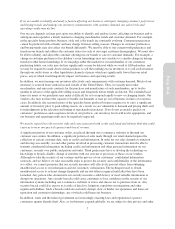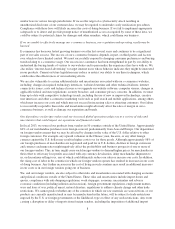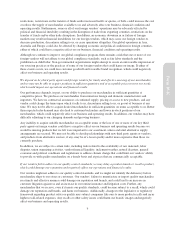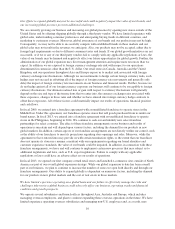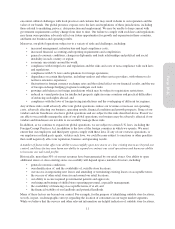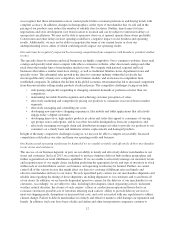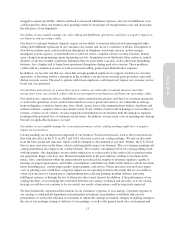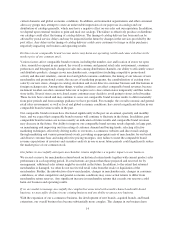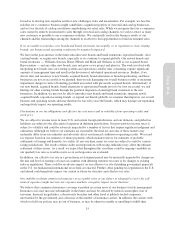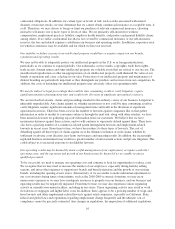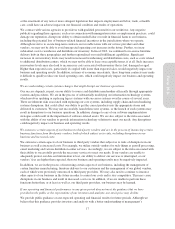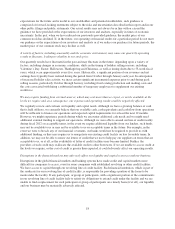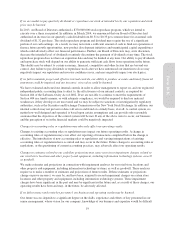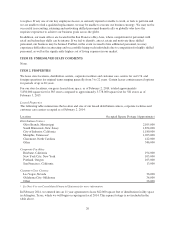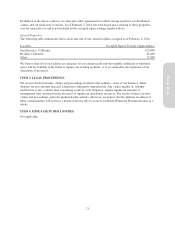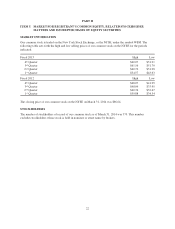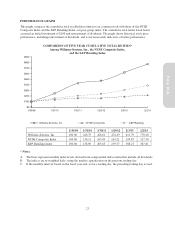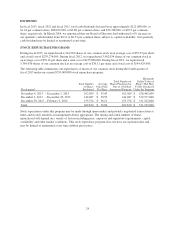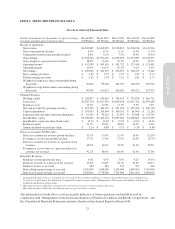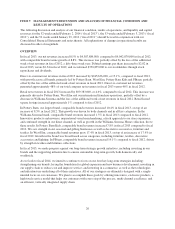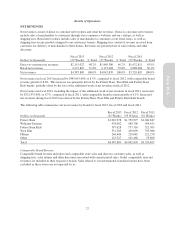Pottery Barn 2013 Annual Report Download - page 31
Download and view the complete annual report
Please find page 31 of the 2013 Pottery Barn annual report below. You can navigate through the pages in the report by either clicking on the pages listed below, or by using the keyword search tool below to find specific information within the annual report.
or the enactment of any new or more stringent legislation that impacts employment and labor, trade, or health
care, could have an adverse impact on our financial condition and results of operations.
We contract with various agencies to provide us with qualified personnel for our workforce. Any negative
publicity regarding these agencies, such as in connection with immigration issues or employment practices, could
damage our reputation, disrupt our ability to obtain needed labor or result in financial harm to our business,
including the potential loss of business-related financial incentives in the jurisdictions where we operate.
Although we strive to secure long-term contracts on favorable terms with our service providers and other
vendors, we may not be able to avoid unexpected operating cost increases in the future. Further, we incur
substantial costs to warehouse and distribute our inventory. In fiscal 2013, we continued to in-source furniture
delivery hubs in three geographies and further regionalized our retail fulfillment capabilities. Significant
increases in our inventory levels may result in increased warehousing and distribution costs, such as costs related
to additional distribution centers, which we may not be able to lease on acceptable terms, if at all. Such increases
in inventory levels may also lead to increases in costs associated with inventory that is lost, damaged or aged.
Higher than expected costs, particularly if coupled with lower than expected sales, would negatively impact our
business and operating results. In addition, in times of economic uncertainty, these long-term contracts may make
it difficult to quickly reduce our fixed operating costs, which could negatively impact our business and operating
results.
We are undertaking certain systems changes that might disrupt our business operations.
Our success depends, in part, on our ability to source and distribute merchandise efficiently through appropriate
systems and procedures. We are in the process of substantially modifying our information technology systems,
which involves updating or replacing legacy systems with successor systems over the course of several years.
There are inherent risks associated with replacing our core systems, including supply chain and merchandising
systems disruptions, that could affect our ability to get the correct products into the appropriate stores and
delivered to customers. We may not successfully launch these new systems, or the launch of such systems may
result in disruptions to our business operations. In addition, changes to any of our software implementation
strategies could result in the impairment of software-related assets. We are also subject to the risks associated
with the ability of our vendors to provide information technology solutions to meet our needs. Any disruptions
could negatively impact our business and operating results.
We outsource certain aspects of our business to third party vendors and are in the process of insourcing certain
business functions from third party vendors, both of which subject us to risks, including disruptions in our
business and increased costs.
We outsource certain aspects of our business to third party vendors that subject us to risks of disruptions in our
business as well as increased costs. For example, we utilize outside vendors for such things as payroll processing,
email marketing and various distribution center services. Accordingly, we are subject to the risks associated with
their ability to successfully provide the necessary services to meet our needs. If our vendors are unable to
adequately protect our data and information is lost, our ability to deliver our services is interrupted, or our
vendors’ fees are higher than expected, then our business and operating results may be negatively impacted.
In addition, we are in the process of insourcing certain aspects of our business, including the management of
certain furniture manufacturing, furniture delivery to our customers and the management of our global vendors,
each of which were previously outsourced to third party providers. We may also need to continue to insource
other aspects of our business in the future in order to control our costs and to stay competitive. This may cause
disruptions in our business and result in increased cost to us. In addition, if we are unable to perform these
functions better than, or at least as well as, our third party providers, our business may be harmed.
If our operating and financial performance in any given period does not meet the guidance that we have
provided to the public or the expectations of our investors and analysts, our stock price may decline.
We provide public guidance on our expected operating and financial results for future periods. Although we
believe that this guidance provides investors and analysts with a better understanding of management’s
17
Form 10-K


